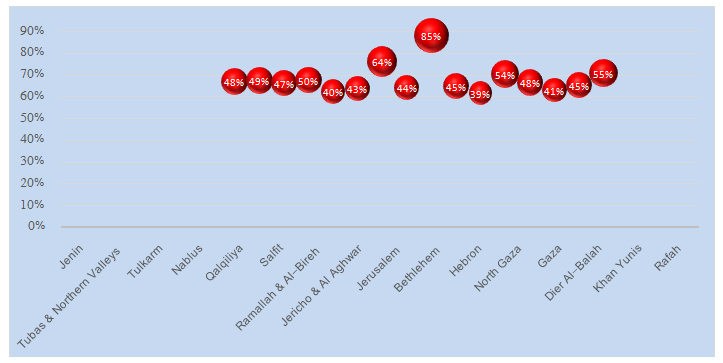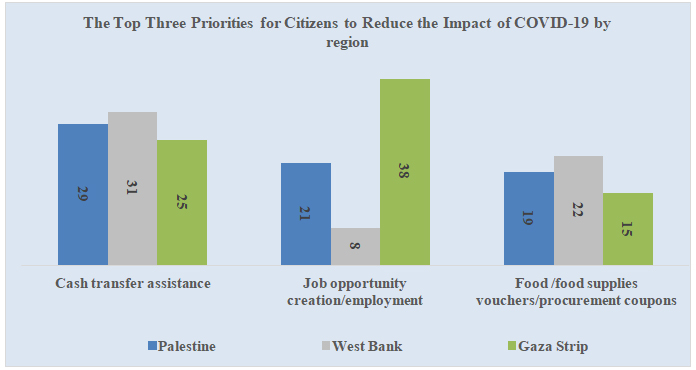Palestinian Central Bureau of Statistics (PCBS) Announces Results of Impact of COVID-19 Pandemic (Coronavirus) on the Socio-economic Conditions of Palestinian Households Survey (March-May), 2020
Palestinian Central Bureau of Statistics (PCBS) took the responsibility to implement a household survey to measure the impact of COVID-19 pandemic (Coronavirus) on the Palestinian households socio-economic conditions, the sample size reached 9,926 households and the time reference for data during the lockdown period from March 5th and up to May 25th, 2020. As well as providing necessary data needed to fulfill/meet the needs of decision and policy makers from the government and both the private and public sectors, in addition to civil society and international institutions in a manner that contributes to developing programs and interventions that can limit the impacts and consequences of this current pandemic.
1. COVID-19 Impact on the Labor Market Reality
One Household's Main Income Earner Out of 6 Stopped Working during the Lockdown Period
It is found that about three out of four of the households' main income earners in the West Bank (73%) worked during the lockdown period that started from March 5th and up to May 25th, 2020. Respectively, one out of seven households’ main income earner in the West Bank (14%) stopped working during the lockdown period. About one out of eight households’ main income earner in the West Bank did not even work before the lockdown period (13%). The emergency state that was declared, in addition to the closure of all public and private institutions as a result of the restrictions imposed by the government to face the Coronavirus pandemic, as well as the home quarantine according to the declared emergency state, were all main reasons for stopping the work at a percentage of 68% in the West Bank.
More than Half of Working Households Main Income Earners were Absent from their Work during the Lockdown Period
54% of workers in the West Bank were absent from work during the lockdown period. The declaration of emergency and the closure of all private and public institutions as a result of the restrictions imposed by the government to face the Coronavirus pandemic, in addition to home quarantine according to the declared emergency state is considered a main reason for absenteeism with a percentage reached 75%.
The effects of lockdown measures impacted the ability to work differently by economic activity in the West Bank, with the industry sector being more affected than any other sector. Accordingly, 51% of main income earners who stopped working were active in the industry sector. Also, workers in the agricultural sector were affected by the lockdown, where 7% of those main income earners who stopped working during the lockdown period were working in the agriculture sector.
Less Working Hours than the Usual
80% of the main income earners experienced a decrease in the workload (less working hours than the usual). This was more felt in the West Bank (83%) than in Gaza Strip (73%). It is slightly more likely that the male income earners to experince a decrease in their workload compared to females (80% for males and 78% for females).
COVID-19 has markedly impacted income streams (wages and salaries). Only 23% of main income earners received their wages as usual, while 25% of them received their wages/salaries partially and 52% of them did not receive any wages/salaries at all during the lockdown period (95% of them work in the private sector, 2% work in the government sector, and 3% work in other sectors). However, the impact of COVID-19 on wages/salaries is very different in West Bank compared with Gaza Strip, as 61% of the main wage earners in the West Bank worked for no wages compared to 31% of them in Gaza Strip did not receive their usual wages. Similarly, there are gender variations, where 26% of the female main income earners did not receive their full wages, which is less than their male counterparts, representing 52%.
2. COVID-19 Impact on Accessing Services
Access to Health Services Was Available to Those Households in Need of Them
4% of households in need of health services were unable to access health services. where the results indicated that the lowest percentages of access were reported for immunization and care of chronic and unchronic conditions.
As for reasons for the inability to accessing healthcare services, the most important reason was that the healthcare centers and hospitals did not receive patients (39%), inability to pay (cover costs) (23%), fear of leaving the house (11%).
Variation in Students’ Participation in Remote/Online Education
51% of households in Palestine with childern between the ages (6-18 years) and are enrolled in education before the lockdown period, whose childern particpated in eductional activities during the lockdown; (53% in the West Bank and 49% in Gaza Strip). Also, there is a clear variartion between the different governorates in terms of students participation, the highest participation was in Jerusalem Governorate (85%), and the lowest was in Hebron Governorate (39%).

Two Out of Every Five Households Evaluated the Remote/Online Experience as Being Bad and did not Fulfill the Desired Task
40% of households, whose childern partcipated in any type of educational activities during the lockdown period, have evaluted the experince as being bad and didn’t fulfill the desired task. However, 39% of them have evaluted it as being good and fullfilled the desired task, but there is a room for enhacing the experience, whereas 21% of them evaluted this experince as being good and fulfilled the desired task.
About Half of the Households their Children were Deprived from Participating in Remote Education Due to Unavailability of Internet
49% of households pointed out that the unavailability of intenet in the household prevented their children from participating in the educational activities during the lockdown period, while 22% of them did not participate due to the fact that the teachers did not perform/conduct any educational activities, and 13% of them did not participate due to the fact that the child him/herself did not want to carry out nor perform educational activities.
3. Food Security and COVID-19 Impact on Livelihoods
Income of Two Out of Every Five Households Decreased to the Half and Even More
42% of Palestinian household's income declined to half and more during the lockdown period compared to February 2020 (46% in the West Bank and 38% in Gaza Strip). Results also showed that 31% of Palestinian households have income resources to cover the household expenditure during the lockdown period (31% of households with male main income earners and 40% of households with female main income earners).
Three Out of Every Five Households Can Cover their Expenses/Expenditures for a Month or Less as Usual in Case the Lockdown is Declared Again
In case of lockdown, 63% of households can cover their expenses/expenditures for a month or less (62% in the West Bank and 68% in Gaza Strip), while 10% of households can cover their expenses/expenditures for four months and more (9% in the West Bank and 11% in Gaza Strip). 61% of the households are worried about not having enough food, while 57% of households have a less diversified diet and 47% cannot eat healthy food.
58% of Palestinian households usually borrow money or buy on credit to cover household's consumption items, including food. Not surprisingly, this percentage has risen up during the lockdown, reaching 63%. It was highest in Gaza Strip compared to the West Bank (79% in Gaza Strip and 52% in the West Bank).
The monthly expenditures on food supplies declined for 41% of the households during the lockdown compared with February 2020 (42% in the West Bank and 40% in Gaza Strip).
4. COVID-19 Impact on Social Assistance Programs
Social protection in Palestine rests on several political interventions ranging from food vouchers programs to job assistance. The programs record more beneficiaries in Gaza Strip than in the West Bank. Around 63% of the households in Gaza Strip receive food vouchers program compared with 5% in the West Bank. Accordingly, households with female main income earners are more likely to be beneficiaries of such programs than households with male main income earners (28% of male income earners and 41% of female income earners).
During the lockdown period, there was a key role for the government and for social solidarity inside the Palestinian community in facing the social and economic challenges resulting from the pandemic, where the data showed that as a result of imposing the lockdown, 15% of households that received assistance in form of food vouchers and food supplies were not benefiting from any assistance and social protection programs before the lockdown, followed by government cash transfers with (5%), and family/friends transfers from inside of Palestine (Domestic) with (4%).
5. Citizens Priorities to Limit the Impact of COVID-19
29% of the households responded that the cash transfer programs are the most desirable measures and procedures the government should be taken in such times of crisis. While job opportunity and employment program came as the second priority at a percentage of 21%. Whereas the third priority expressed by the respondents of the phone survey was food vouchers, food supplies parcels and procurement coupons (19%); taking into consideration that there is a variation between the West Bank and Gaza Strip as shown below.
| |
 عربي
عربي
